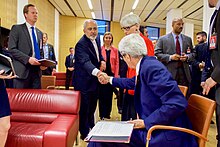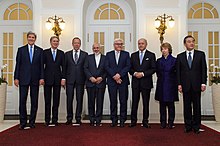Joint Comprehensive Plan of Action
The sanctions applied to all countries and companies doing business with Iran and cut it off from the international financial system, rendering the nuclear deal's economic provisions null.[13] In 2018, IAEA inspectors spent an aggregate of 3,000 calendar days in Iran, installing seals and collecting surveillance camera photos, measurement data, and documents for further analysis.[20] In November 2018, U.S. sanctions came back into effect, intended to force Iran to alter its policies, including its support for militant groups in the region and its development of ballistic missiles.[31] This was followed by the Paris Agreement in November 2004, in which Iran agreed to temporarily suspend enrichment and conversion activities, including those related to centrifuges, and committed to working with the EU-3 to find a diplomatic solution".[35] The resolutions demanded that Iran cease enrichment activities, and imposed sanctions, including bans on the transfer of nuclear and missile technology to the country and freezes on the assets of certain Iranian individuals and entities.[47] In September 2013 Obama and Rouhani spoke by telephone, the first high-level contact between U.S. and Iranian leaders since 1979, and Secretary of State John Kerry met with Foreign Minister Mohammad Javad Zarif.[65] With cooperation from the "Working Group" (the P5+1 and possibly other countries), Iran was permitted to modernize the Arak heavy water research reactor based on an agreed design.By contrast, Alan J. Kuperman, coordinator of the Nuclear Proliferation Prevention Project at University of Texas at Austin, disagreed, arguing that the breakout time would be only three months.Many countries expressed hope that it could achieve its goals,[118][119][120] while Iranian adversaries in the Middle East, including Israel and Saudi Arabia,[10][11] and some U.S. lawmakers saw it as defective and appeasing Iran."[90] An analysis by the Carnegie Endowment for International Peace claimed that the final agreement was based upon (and buttressed) "the rules-based nonproliferation regime created by the Nuclear Non-Proliferation Treaty (NPT) and including especially the IAEA safeguards system".[177] Obama repeatedly urged Congress to support the agreement, noting the inspections regime's vigor and criticizing opponents for failing to offer a viable alternative.[218][219] Conversely, in late August a group of 900 rabbis signed an open letter by Kalman Topp and Yonah Bookstein calling upon Congress to reject the agreement.[242] Republican Committee chair Ed Royce claimed that the deal traded permanent sanctions relief for temporary restrictions[242][243] and criticized the inspection regime.[244][245] Secretary of Defense Ashton Carter, General Martin Dempsey, the chairman of the Joint Chiefs of Staff, Kerry, Moniz, and Lew appeared before the Senate Armed Services Committee.[185] President Obama argued that renegotiation was unrealistic, that the Iranian people would see further concessions as "total surrender of their sovereignty",[269] and that other countries would not continue to support the existing sanctions regime.[275] The Associated Press reported that the classified U.S. Intelligence Community assessment concluded the agreed inspection regime would diminish Iran's ability to conceal a covert weapons program.[285] A key part of obtaining even limited support came during an August 2015 meeting at which top diplomats from the UK, Russia, China, Germany, and France told 10 undecided Democratic senators they had no intention of returning to negotiations.[290][291] The same day, Congress passed resolutions claiming that the requirements of a congressional review period were not met (by party-line vote) and that that would prevent the U.S. from lifting any sanctions[290][292] (all Republicans and two Democrats in favor).[297] A two-page, top-secret directive from Iran's Supreme National Security Council instructed newspapers to avoid criticism or giving any impression of disagreement at the highest levels of government.[300] The anti-agreement coalition included former president Mahmoud Ahmadinejad, former head of AEOI Fereydoon Abbasi, ex-nuclear negotiator Saeed Jalili, and various conservative clerics and IRGC commanders.[313] On 20 September 2015, Director-General Yukiya Amano of the IAEA went to the Parchin missile production facility, along with Director of Safeguards Tero Varjoranta, to obtain clarifications on the site's nuclear activities."[326] Michael Eisenstadt, Director of the Military and Security Studies Program at the Washington Institute for Near East Policy, wrote that deterrence must remain the "core imperative" for U.S.[330] Dennis Ross and David Petraeus claimed that deterrence including military force was essential to preventing Iran from nuclear weapons and called on Obama to clearly state that policy.Trump listed three items that could provoke the U.S. to reject deal: intercontinental ballistic missile development, Iranian refusal to extend the constraint period, and evidence that Iran had reduced the time needed to manufacture a bomb to fewer than 12 months.[337] Rouhani,[338] Theresa May, Emmanuel Macron, Angela Merkel, and European Union foreign policy chief Federica Mogherini said the agreement was working well and that no one country could break it, reconfirming support for the deal.[338] On 8 May 2018 the U.S. officially withdrew after Trump signed a Presidential Memorandum ordering sanctions reinstatement,[339] opting instead to seek a comprehensive and lasting solution working allies.[391] An IAEA report on the Fordow Fuel Enrichment Plant found that two cascades of IR-6 centrifuges were configured in a way "substantially different" from what Iran had previously declared.[396] In late August, after months of negotiations, first in Oman and then with Qatari officials in New York, agreements between the U.S. and Iran led to a gradual easing of sanctions on Iranian oil sales, particularly for eastern markets such as China.[410] On November 13, IAEA director Rafael Grossi visited Tehran where he was welcomed by Behrouz Kamalvandi, spokesman for the Atomic Energy Organization of Iran (AEOI).Grossi, holding talks with Foreign Minister Abbas Araghchi and AEOI Chief Mohammad Eslami, had earlier said the JCPOA was an "empty shell" but that IAEA inspectors had no evidence that Iran was building a nuclear bomb.










United Nations Security Council Resolution 2231Comprehensive Plan of ActionRatifiedDate effectiveViennaFranceGermanyRussiaUnited KingdomEuropean UnionUnited StatesNuclear non-proliferationPersianromanizedIranian nuclear programpermanent members of the United Nations S.C.Joint Plan of ActionIran nuclear deal frameworkInternational Atomic Energy AgencyArak IR-40 reactorBushehr Nuclear Power PlantFordow Fuel Enrichment PlantIsfahan Uranium Conversion PlantNatanz Uranium Enrichment PlantParchin Military Research complexIsraelSaudi ArabiaIranian principlistsenriched uraniumgas centrifugesheavy-water facilitiesproliferationUnited Nations S.C.nuclear-related sanctionsSecurity Council Resolution 2231PresidentDonald TrumpU.S. domestic lawYukiya Amanocovert nuclear weapons programNuclear program of IranTimelineFacilitiesBushehrDarkhovinFordowNatanzIsfahan Nuclear Technology/Research CenterKarun atomic energy siteAtomic Energy Organization of IranOghab 2Non-Proliferation Treaty2013 interim agreement, Geneva2015 prelim agreement, LausanneReactionsAftermathNegotiationsUnited States withdrawalNuclear Achievements ActIranian act implementing the JCPOAMajlis commissionUS Congress reviewIranian nuclear negotiatorsRouhaniLarijaniJaliliAbbasiAghazadehElBaradeiFakhrizadehSalehiAssassination of nuclear scientistsAMAD ProjectIran and WMDAli Khamenei's fatwa against nuclear weaponsIran–United States relations after 1979Sanctions against IranUN resolutionsWMD-free zoneMossad infiltration of Iranian nuclear archiveViews on Iran's nuclear programU.S. withdrawal from JCPOAballistic missilesNuclear proliferationnuclear weaponfissile materialnuclear chain reactionuranium 235plutonium 239uranium 233reactor-grade plutoniumuranium 238enrichednuclear powerdual-use technologyproliferation of nuclear armsnuclear technologyAtoms for PeaceTreaty on the Non-Proliferation of Nuclear WeaponsIranian RevolutionRuhollah Khomeiniagreement with IranPakistanA.Q. KhanNational Council of Resistance of IranMohammad KhatamiMahmoud AhmadinejadEsfahanresolution (nr. 1696)United Nations CharterMohamed ElBaradeiNational Intelligence EstimateU.S. Intelligence CommunityBarack ObamaJohn KerryJavad ZarifWilliam BurnsJake SullivanHassan RouhaniyellowcakeMohammad Javad ZarifHezbollahCentral Intelligence AgencyDrug Enforcement AdministrationProject CassandraJeff Sessions